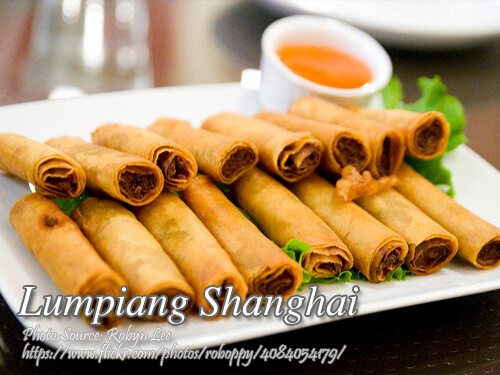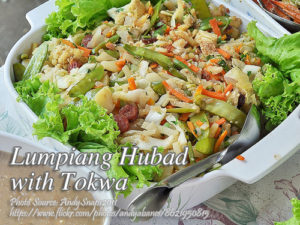Lumpiang shanghai is a fried springroll with meat fillings, an all time favorite finger food or viand among Pinoys. You will never miss this springroll in most Filipino restaurants or fastfood. Making this dish is so simple yet so appetizing specially if you combine it with your favorite dipping sauce.
Unlike other kinds of springroll, you can’t increase the thickness of the filling because you are using ground raw meat. It’s because when you fry it, you will burn the wrapper before the meat inside the lumpia is cooked if the filling is too thick. And with regards to the meat used in the filling, you can use beef or chicken if you abstain from eating pork.
Lumpiang Shanghai: A Family Favorite on Every Table
When I think of Filipino gatherings, one dish always takes the spotlight: lumpiang shanghai. Birthdays, fiestas, even a simple Sunday lunch—there it is, sitting proudly on the table, gone before you even get to your second plate of rice. My earliest memory of it was during a summer trip to my Lola Ester’s house in Pampanga. She would fry batch after batch while we cousins lined up with plates, waiting for the first golden rolls to hit the table. She always joked that making these spring rolls was a test of patience—especially when hungry kids were around.
Why This Crispy Spring Roll Wins Every Time
There’s a reason this crunchy treat has become a staple at every Filipino gathering. Compared to other types of lumpia, this one is filled with ground meat, usually pork, which keeps it simple but incredibly tasty. My Uncle Rodel, who worked in a carinderia back in Cebu, once explained to me why the filling shouldn’t be too thick. If you pack in too much meat, the wrapper burns before the inside cooks. He said the best ones are rolled just as thin as your finger, ensuring every bite is both crisp and fully cooked. I never forgot that tip, and it’s exactly how I make them today.
Mixing the Filling the Right Way
I still remember the first time my cousin Marites taught me how to prepare the filling. She dumped the pork, garlic, onion, carrots, and green onions into a big bowl and mixed everything with her hands. She told me the warmth of your palms helps blend the flavors better than just poking around with a fork. At first I hesitated, but she slipped me a pair of disposable gloves and insisted I try. She was right—the mixture turned out smoother, more even, and the flavors mingled beautifully. That hands-on technique is still my go-to whenever I prepare a big batch.
Rolling Lumpiang shanghai Like a Pro
Rolling these spring rolls can feel intimidating for beginners, but here’s what I learned: it’s all about keeping things snug and neat. My younger brother Junjun, who once helped in a small turo-turo in Davao, showed me a trick. He laid the wrapper flat, placed the filling carefully in the middle, and shaped it into a slim log. He reminded me not to overfill, then rolled it halfway, tucked the sides in, and sealed the edges with a touch of water. “Think of it like wrapping a small gift,” he said. That simple comparison stuck with me, and since then, rolling lumpia has felt like second nature.
Frying Lumpiang shanghai to Crispy Perfection
The magic really happens once the rolls hit hot oil. I like to fry them in batches, never overcrowding the pan so each one cooks evenly. My Tita Lorna from Batangas always told me that the key to perfect lumpiang shanghai is watching the oil temperature. Too hot, and the wrapper burns. Too low, and the rolls soak up too much oil. Medium-high heat is the sweet spot, giving you that golden, crunchy bite that everyone loves. When done, I let them rest on paper towels or a colander to drain off the extra oil before serving.
A Dish with History
What’s fascinating is that this beloved dish carries a bit of history, too. The word “shanghai” hints at its Chinese roots, since spring rolls were introduced to the Philippines centuries ago through trade and migration. Over time, Filipinos made the recipe their own, filling it with pork, beef, or even chicken, and serving it with vinegar or sweet-and-sour sauce. It’s a perfect example of how Filipino cuisine borrows, adapts, and transforms flavors into something uniquely ours.
Best Served with Sauce and Smiles
For me, no lumpia plate is complete without dipping sauce. My father swears by spicy vinegar, while my nieces prefer sweet banana ketchup. Sometimes, if I feel fancy, I’ll whip up a sweet-and-sour glaze. Whatever the dip, the crunchy roll always disappears faster than I can fry the next batch. That’s the charm of this dish—it brings people together, makes conversations livelier, and reminds us of every fiesta and family reunion we’ve ever had.
Final Thoughts on Lumpiang Shanghai
Making lumpiang shanghai may seem simple, but every step carries a bit of love, patience, and memory. From mixing the filling by hand to carefully rolling each piece, it’s the kind of dish that teaches you not just cooking techniques, but also family traditions. So the next time you prepare a batch, remember the little tips passed down by titas, lolas, and cousins. Serve it hot, crunchy, and with your favorite dip, and you’ll understand why this humble roll remains one of the most cherished dishes in Filipino homes.
How to Make Lumpiang Shanghai
Ingredients
- 1 kilo ground pork or ground chicken or beef
- 1 pc medium onion finely chopped
- 1 pc carrot finely chopped
- 1/8 cup soy sauce
- 2 tsp. ground black pepper
- 1 Tbsp. minced garlic
- 1/2 Tbsp. salt
- 1 Tbsp. brown sugar optional
- 1 Tbsp. green onion finely chopped
- 2 cups grated cheese (optional)
- 50 pcs small lumpia spring roll wrappers
- cooking for deep frying
Instructions
How to make Lumpiang Shanghai:
- Combine all ingredients in a bowl starting with the pork, onion, carrots, garlic, green onion.
- Mix well using a fork or preferably your hands. You can use a plastic disposable gloves to be sure that the mixture in free from contamination.
- Then gradually add the rest of the ingredients: soy sauce, pepper, salt and sugar. Mix very well until the all the ingredients are uniform in texture. Add grated cheese if you want to make it cheesy.
- To make the lumpia, lay a piece of lumpia wrapper in a flat surface. Put about 2 tablespoon of the meat mixture on the center and form it into a log shape.
- Make sure the filling will be too thick, not thicker than your finger. Fold one edge of the wrapper towards the center and roll it half way to from a log shape.
- Fold both sides of the wrapper (adjacent to the previous fold that you made) towards the center.
- Roll the lumpia until it forms a log shape. Seal the edges with a dab of water to moistened it.
- Do the same procedures to the rest of the batch. Heat oil in a frying pan and fry the lumpia until golden brown and crispy.
- Place on a colander or paper towel to drain excess oil. Serve with dipping sauce either catsup, sweet and sour sauce or spiced vinegar (sinamak).
Video
Notes
Cooking Tips for Lumpiang Shanghai:
Keep the Filling Thin
When preparing the rolls, avoid making the filling too thick. If the meat mixture is too packed, the wrapper will burn before the inside cooks properly. A filling no thicker than your finger ensures a perfectly cooked, juicy center with a crisp golden shell.Seal the Edges Properly
To keep the rolls from bursting open during frying, always seal the edges with a dab of water. Some home cooks even use a bit of beaten egg for a stronger hold. This step helps maintain the shape and prevents oil from seeping inside the lumpia.Fry in the Right Temperature
Oil temperature is key for the perfect crunch. If the oil is too hot, the wrapper browns quickly while the inside stays raw; too low, and the rolls absorb excess oil. Medium-high heat gives that even golden crispness that makes lumpiang shanghai irresistible.






Hi Manny!
My husband and I love lumpia so much I wish I could cook it everyday. Problem is we are trying to keep away from deep fried foods and we don’t appreciate the oily lumpia scent that lingers in the house after cooking it. Any suggestions on how I can bake it instead?
Thank you so much!
Hi Mitch, yes you can bake this lumpiang shanghai using this method. Preheat oven to 450°F and place the lumpia on a baking sheet or cookie sheet, seam side down. You can also grease the baking sheet first before placing the lumpia. Then bake for 10 minutes, turn once, then bake for another 5 minutes or until golden brown.
Use an AIR FRYER
Your lumpiang Shanghai looks tasty and mouth watering! I will try to cook this tonight. Thanks Manny!
Hi Evelyn, I’m happy to know that you like this lumpiang shanghai! You might also try other fried springrolls like lumpiang bangus.